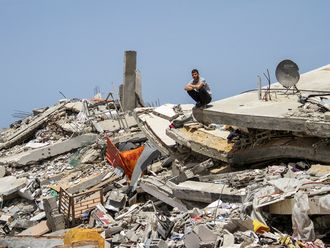Damascus: US troops in one small outpost in the south of Syria may be preparing for a longer stay, even as administration and military officials try to work out the details of President Donald Trump’s plan to withdraw.
The American base at Al Tanf, originally established as a southern foothold against Daesh and a training ground for Syrian rebels, has become one of the main obstacles to the president’s plan to leave. Israeli and some US officials argue that a continued American presence there is critical to interrupting Iran’s supply lines into Lebanon, where Hezbollah — Iran’s proxy and Israel’s enemy — has been building up its arsenal.
US troops at the base established a 55-kilometre “deconfliction zone” including part of the strategic Damascus-to-Baghdad highway. The surrounding territory is controlled by forces loyal to Syrian President Bashar Al Assad, who’s backed by Iran and Russia.
The debate over what to do with Al Tanf reveals US goals in Syria that go beyond the official rationale of defeating Daesh — complicating Trump’s desire to exit. The administration also wants to constrain Iran’s influence, including by limiting its ability to use Syria as a launching point for operations against Israel.
“It all depends on Trump,” said Aaron Stein, director of the Middle East program at the Foreign Policy Research Institute in Philadelphia. “He ordered US forces to leave Syria. There have been efforts to pare that back and to treat Al Tanf as separate from the northeast, but it’s unclear if the president will be convinced.”
Israeli Prime Minister Benjamin Netanyahu has been doing his best, and he has the president’s ear, according to one senior US diplomat, who asked not to be named citing confidential discussions. Netanyahu has repeatedly urged the US to keep troops at Al Tanf, according to several senior Israeli officials, who also asked not to be identified discussing private talks. Even if they don’t do much, the mere presence of American troops will act as a deterrent to Iran, the Israelis say.
Iran hawks
That argument holds sway with Iran hawks in the US administration, including National Security Adviser John Bolton, who’s been talking down a speedy US withdrawal. On a recent trip to Israel and Turkey, Bolton indicated that there would be no rush to remove troops from Al Tanf, although it wasn’t clear if he sought the kind of long-term US presence there that Israel wants.
The Israeli demands seem to have been reflected in other public statements from the US, as the emphasis switched away from a speedy removal of all forces, and toward pulling out of the northeast. There are concerns in that part of Syria too, over the fate of Kurdish fighters supported by the US but viewed as terrorists by Turkey, which is threatening to attack them.
It’s also unclear how the US could maintain a relatively small presence of no more than a few hundred troops at Al Tanf as Al Assad reimposes his grip on the rest of the country.
‘Once they’re in’
Russia has been sceptical of Trump’s announcement from the start.
“I don’t believe Americans will leave,” Frants Klintsevich, a member of the defence and security committee in the upper house of Russia’s parliament, said in a phone interview Friday. “Once they are in, they stay.”
But he predicted that “in the end the US will just have this Al Tanf base, and nothing more.” And he said that when that happens, “Russia and Syria will increase pressure on the US to withdraw.”
Even if the US resists that pressure, says Stein, it’s unlikely that its troops there will achieve much. He sees a mismatch between the grand geostrategic claims being made about the base, and the reality of a small, isolated outpost in the desert, surrounded by hostile forces.
Al Tanf is “a vulnerable fire base that Iran and Russia fly over every day,” he said. “There is no strategy here.”












